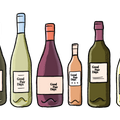

Let's look at the range of white grape varieties, broken down by style. Click through for more info on each variety!
So much to cover here, but essentially white wines are made from white grapes and don't have any skin contact. What's that? We'll cover it a little later, but it's good to know that colour in wine comes from the pigment in the grape skin, and so if the juice and grape skins can't get cozy (skin contact), you'll have a relatively colourless wine. Like the majority of your favourite whites.
The main white grapes you're going to see are Chardonnay, Riesling, Sauvignon Blanc and Pinot Gris. There's a bunch more, but these are the 'Big 4'. These wines are best drunk straight from the fridge, although in some rarer cases they taste a bit better after warming up for a few minutes
What is white wine?
You know the deal - white wine is made from white grapes. Sometimes they're green, or a bit yellow, but for the sake of ease, we'll refer to them as white. These grapes don't have a whole lot of colour in their juice, although there may be a little in their skin. The majority of colour in wine comes from the skin, so as long as the skins aren't macerated into the juice, you'll get a white wine!
What are the characteristics of white wine?
There's a few main differences in the flavours and textures of white and red wines. One of the biggest differences is the levels of acidity that you'll find. Traditionally, white grapes are harvested (a fancy word for 'picked') earlier in the year than red grapes. This emphasises acidity over rich flavours and lends a refreshing quality to the wines. The majority of white wines are also not oaked (yeh sure, there's plenty that are, but we're talking the whole shebang), and this reinforces the refreshment.
White wines will also tend towards flavours that involve citrus fruits and tree fruits - that is, stuff like lemon and apple. This is a different kettle of fish to reds, which tend to involve more berries, plums and the like.

Once you've broken down the colours of wine, the next logical step to categorise them is by variety. It can be tricky sometimes to say categorically for example that all Sauvignon Blanc is light bodied. There's certainly plenty of richer wines being made from that grape variety out of the Loire Valley.
There are some 'typical standards' however that give a good indication of the usual style of a certain grape, and so that's how we've broken them down below. Click through for more info on each variety!
Light--red
These wines are at the fresh end of the spectrum - lighter in alcohol and weight. They slip down easily, with no heaviness.
Medium--aromatic
This is the majority of wines - they have a bit of stuffing, but are well balanced and don't have excess tannin or alcohol.
Full--racy
These are the richer styles, with plenty of alcohol or tannin, or both! Lots of fruit here, often accompanied by oak.
FAQ
How many types of white wine are there?
There are over 600 different types of white grape varieties found around the world, although most people will normally only drink a handful of these.
Which white wine is dry?
The majority of wine made around the world is dry (ie not sweet). It is not particularly linked to grape variety - most grapes can be made into a dry or a sweet wine.
What is a full bodied white wine?
The richest, or most full-bodied, grape varieties are Chardonnay, Viognier, Marsanne and Roussanne.
What is the best white wine to drink for health?
Any wine that is lower in alcohol is better for you. Some examples include Moscato (although there is more sugar in these styles), Riesling and Semillon.
What is the sweetest white wine?
Many dessert wines are made from white grapes. Styles such as Sauternes, Moscato, Auslese and Tokaji are all very sweet.
About the Author
Banjo Harris Plane is the three-time winner Sommelier of the Year Australia and a certified advanced Sommelier through the Court of Master Sommeliers. He first cut his teeth in the wine industry working as a sommelier in Australia's best restaurants, before starting multiple businesses in the space of a few years... these included two restaurants, a wine import business and co-founding Good Pair Days!
Do you know your wine personality? If your answer is no, take our quiz to find out which wines to pick up next and build your box!
Build my box





